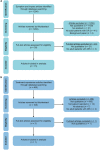The Patient Experience with Diabetic Retinopathy: Qualitative Analysis of Patients with Proliferative Diabetic Retinopathy
- PMID: 36460939
- PMCID: PMC9834467
- DOI: 10.1007/s40123-022-00614-8
The Patient Experience with Diabetic Retinopathy: Qualitative Analysis of Patients with Proliferative Diabetic Retinopathy
Abstract
Introduction: Few qualitative studies have explored the patient experience of daily life with proliferative diabetic retinopathy (PDR) and associated treatments. Herein, a conceptual model was developed to comprehensively examine symptoms, functional impacts, and treatment experiences in PDR.
Methods: A qualitative, mixed-methods study comprising a literature search and semi-structured interviews with clinicians and patients was conducted. Published literature and online patient resources were searched to identify concepts relevant to patients, including symptoms, functional impacts, and treatment experiences of PDR. Semi-structured interviews with experienced clinicians were conducted to identify symptoms and impacts reported by patients with PDR and to receive feedback regarding concepts identified from the literature search. A preliminary conceptual model was then developed based on findings from the literature search and clinician interviews. Patients with PDR participated in two rounds of semi-structured interviews to identify additional concepts relevant to the patient experience in PDR and associated treatments, which informed revisions to the conceptual model. Saturation of patient interviews was assessed.
Results: Findings from the literature search and clinician interviews yielded 109 concepts that were included in a preliminary conceptual model with three overarching domains: symptoms, impacts, and managing the disease. Clinicians confirmed concepts identified from the literature search. During interviews, patients reported a broad spectrum of symptoms (e.g., red vision); functional impacts relating to activities of daily living (e.g., reading), emotional functioning (e.g., loss of independence), and social functioning (e.g., problems recognizing faces); and treatment experiences (e.g., improves eye problems, no change) associated with PDR. Additional concepts elicited in patient interviews informed revisions to the conceptual model. Saturation was achieved in the patient sample.
Conclusions: A wide variety of symptoms, functional impacts, and treatment experiences that significantly affect health-related quality of life were identified in patients with PDR. These insights are critical for understanding PDR symptomology and assessing treatment response.
Keywords: Aflibercept; Diabetic retinopathy; Patients; Photocoagulation; Symptoms.
© 2022. The Author(s).
Figures



References
Grants and funding
LinkOut - more resources
Full Text Sources

